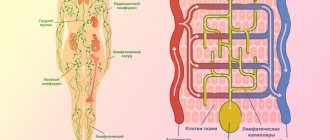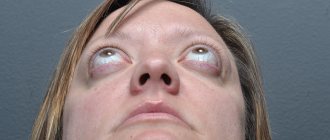Anisocoria is a symptom in which the pupils are different sizes. This condition is caused by the fact that one eye reacts correctly to light stimuli (the pupil narrows in bright light and dilates in insufficient light), while the other remains in a fixed position.
Anisocoria can be of several types:
- Congenital. It is observed in children with an incompletely formed nervous system or brain or disorders in embryonic development. Pupils of different sizes in a child are considered a pathology, however, as a rule, they do not in any way affect the quality of life. Over time, the defect may disappear.
- Physiological. This is the name given to the natural state when the pupils at rest differ in diameter by no more than 1 mm. In this case, it is enough to drop drops that dilate the pupil so that both eyes become symmetrical again.
- Pathological. The symptom develops against the background of ophthalmological or neurological disorders. Diagnosis and treatment are necessary.
Pupil: what is it and why does it change size
The pupil is the hole in the iris of the organ of vision in humans and animals. It is through it that light streams enter the eye.
The size of the pupil directly depends on the functioning of the autonomic nervous system and is determined reflexively under the influence of various factors. First of all, this is the brightness of the lighting: the darker the room, the more the pupil dilates. Also, its diameter can be affected by pain or emotional sensations, or taking certain medications.
The pupil contracts and dilates due to the coordinated functioning of the iris muscles, which receive appropriate signals from the oculomotor nerve. Normally, they act synchronously (for example, if you direct light to one eye, the pupils of both will decrease in diameter equally) - this is a feature of the human organ of vision. The size of the pupil changes dynamically; over the course of a minute it is capable of making from 30 to 120 vibrations, and the diameter can vary from 1.1 to 8 mm.
A difference of within 1 mm is normal for human pupils. This is physiological anisocoria, it is observed in approximately 20% of the population (the vast majority of them note that the right pupil is wider than the left).
to contents ^
General information
Anisocoria is an abnormality of the iris of the eyes, which is characterized by different sizes of the pupils of a person's eyes or their unfriendly reaction.
In this case, most often the functioning of one pupil is normal, and the second is absent, that is, the size of the pupil is constantly fixed, its arc of the pupillary reflex is disturbed - the illumination of the eyes and, as a result, excitation impulses along the fibers of the optic tract on one side do not completely reach the center of the oculomotor nerve. In individuals with lesions of the nervous system, pupils of different sizes are observed in 50-90% of cases, with visceral diseases - no more than 37%, most often in old age.
There is a concept of physiological (essential) anisocoria - the difference in pupil sizes is no more than 0.9 mm. It is observed in approximately 10% of people, without causing disturbances in other reflexes. For example, during migraine , anisocoria is transient.
Symptoms of anisocoria
In itself, being a symptom indicating the presence of trouble in the body, anisocoria is expressed in the fact that the difference in the diameter of the pupils becomes visually noticeable. One eye works as before, but the pupil of the second does not react properly to light, maintaining a fixed size. In conditions of sufficient lighting, the pupils can be almost the same, but when it decreases, the difference becomes noticeable.
Physiological anisocoria usually makes itself felt only in low light conditions; the reaction to light remains within normal limits. After using pupil dilating agents, it disappears.
With pathological anisocoria, the pupil located on the affected side enlarges more slowly, and the reaction to light is sometimes completely absent.
The unevenness of the pupils usually causes only discomfort of an aesthetic nature, however, this condition can be accompanied by concomitant manifestations that give the patient a lot of unpleasant sensations.
- Increased fatigue due to visual stress (while working at the computer).
- Pain and swelling of the cornea.
- Limited mobility of the eyeball.
- Ptosis is drooping of the upper eyelid.
- Diplopia is the bifurcation of the object in question, while the visible images may shift horizontally, vertically, or diagonally.
- Proptosis is anterior protrusion of the eyeball.
In addition to ophthalmological manifestations, a difference in pupil diameter may be accompanied by general symptoms:
- impaired coordination of movements;
- cephalalgia (pain in the head), only temporarily relieved with analgesics, dizziness;
- speech disorders;
- hand tremors, paresis, partial paralysis;
- visual disturbances (“floaters” before the eyes, decreased visual acuity);
- nausea, vomiting.
If uneven pupils are accompanied by the listed symptoms, urgent medical attention is needed.
to contents ^
Why the pupils are different: causes of anisocoria
Uneven pupils can be the result of a congenital defect in the elements of the organ of vision or underdevelopment of its nervous system. The muscular apparatus of the iris does not function correctly, causing asynchrony of the pupillary reaction to light. Such anisocoria is defined as congenital.
Asymmetry of the pupils can also be acquired. It may be based on several groups of reasons:
- Injuries to the organ of vision, damaging its iris and ligamentous apparatus. Even if there are no visible lesions, paralysis of the muscular structure of the iris may form, and an increase in intraocular pressure is possible - these factors lead to a difference in the diameter of the pupils. A similar reaction can also occur after surgery (for example, as a result of cataract removal).
- Traumatic brain injuries affecting the visual centers in the cerebral cortex and leading to damage to the nervous system of the eye. Pathological pupil dilation is usually present on the affected side, often accompanied by strabismus.
- The use of drugs that affect the width of the pupil (a similar reaction can be provoked by acetylcholine, pilocarpine, atropine, adrenaline and other drugs), as well as drug use.
- Paralysis of the oculomotor nerve, which controls the muscles that control eye movements.
- Inflammatory and non-inflammatory ophthalmological pathologies (iritis - a disease of the iris of the eyeball), Adi's syndrome - pathological dilation of the pupil, due to which it stops responding to light), glaucoma - damage to the optic nerve (anisocoria can occur during an attack of the closed-angle form of this pathology).
- Benign and malignant brain tumors.
- Pathological processes affecting the upper parts of the lungs (tuberculosis, tumors).
- Neurological pathologies (stroke, aneurysm, migraine, diabetic neuropathy - a complication of diabetes). Similar conditions can also be of infectious origin (neurosyphilis - a disease of the central nervous system that occurs due to the penetration of syphilis pathogens into it, meningitis, tick-borne encephalitis).
The most serious causes of anisocoria are conditions called vascular accidents of the brain: ischemic stroke (or cerebral infarction), hemorrhagic stroke caused by bleeding in the brain. Here, pupillary asymmetry occurs against the background of severe headache, tachycardia, nausea and vomiting, high blood pressure, consciousness, motor abilities and facial expressions may be impaired. The patient’s appearance also changes: his skin turns red and sweating increases.
If there is a suspicion that anisocoria is caused by a vascular accident in the brain, you should immediately seek medical help.
Anisocoria is part of a symptom complex called Horner's syndrome, indicating damage to the sympathetic nervous system. This reason for pupillary asymmetry is described in detail in the video:
to contents ^
Prevention
Prevention of anisocoria is not always possible. However, some measures can reduce the risks of its occurrence (including recurrence):
- Maintaining the general condition of the body, immunity;
- Timely treatment and relief of diseases;
- Avoiding situations that pose a risk of injury;
- Maintaining a diet and maintaining a healthy lifestyle;
- Undergoing preventive examinations with an ophthalmologist (at least once a year);
- If discomfort and the first symptoms of visual impairment occur, seek medical help promptly.
Prevention of anisocoria includes:
- Timely visit to a neurologist or ophthalmologist when the first symptoms of anisocoria appear.
- Cholesterol level control and correction.
- Blood pressure control.
- Controlling blood sugar levels.
Among preventive actions, the most important thing is to sound the alarm in time and find out the cause of the deviation. If the problem is solvable and does not pose a threat to the health and life of the patient, recommendations will be limited to advice on maintaining a healthy lifestyle. But, in any case, it is necessary to strictly follow the instructions of the attending physician and adhere to the prescribed therapy. Only with complete mutual understanding between the doctor and the patient can a positive result be achieved and quickly get back on your feet.
Anisocoria in children and adults
At different age stages, the causes of pupillary asymmetry may differ.
In children, anisocoria is often congenital, especially if this has been observed in someone in the family: in this case, they speak of a genetic predisposition. This condition is often observed from the moment of birth and may be accompanied by strabismus.
An acquired form of anisocoria in childhood can develop due to underdevelopment of the autonomic nervous system. If this is the reason, then by the age of 4-5 years the difference in pupil diameter is gradually leveled out.
It happens that uneven pupils in a child appear as a result of falling and hitting their head on a hard surface, as well as due to birth trauma.
Different pupils can become a reaction of the child’s body to the use of eye drops, poisoning with toxic substances, or intoxication after an insect bite (tick-borne encephalitis).
Anisocoria in children can accompany infectious diseases (meningitis, meningoencephalitis).
A child with a visually noticeable difference in pupil size should be shown to a doctor to exclude the possibility of serious pathologies. Sudden anisocoria should be especially alarming.
In adults, ophthalmological and neurological diseases come to the fore as causes of pathological pupillary asymmetry. If anisocoria appears in adulthood, it is important to be vigilant, as it may indicate problems with the brain.
to contents ^
Preventive actions
Preventing the occurrence of differences in pupil size through any preventive measures has not been established.
People at risk should pay special attention to their eyes, namely:
- people actively involved in sports, especially those types where there is direct contact (boxers, hockey players, tennis players, etc.);
- people who, due to the nature of their professional activities, often have to be in situations where the face, skull, and cervical vertebrae may suffer (builders, firefighters, miners, etc.).
They must not neglect personal protective equipment for the body, especially the head and neck.
And, of course, the main preventive measure is maintaining a healthy lifestyle and getting rid of drug and alcohol addiction.
The conclusions to be drawn from this article are based on a simple rule. You should always take your health seriously. The body often sends us calls about some failures in the coordinated work of all organs. They cannot be ignored. Otherwise, irreversible consequences of our inattention to ourselves will occur. Of course, manic concern for one’s health is an extreme. But how many times, banal professional examinations, revealed diseases in people that they did not even suspect. This fully applies to anisocoria. Take care of your eyes.
Diagnosis and treatment of anisocoria
When pupil disparity becomes apparent, it is important to consult a doctor promptly, as this symptom may indicate a problem that requires immediate treatment. When preparing for your first visit to a medical facility, it is advisable to take with you old photographs that clearly show the patient’s face: this will help in making an accurate diagnosis.
Diagnostic procedures
Diagnosis begins with identifying the eye in which the pathology is present - for this purpose, the doctor evaluates the pupillary reaction to light.
First, traumatic injuries and medications that could potentially cause pupil asymmetry are ruled out.
By examining the eyeball with a slit lamp, the doctor determines whether there are organic lesions (this procedure is called eye biomicroscopy). Diaphanoscopy may also be required - transillumination of the eye tissues, performed in a darkened room with a diaphanoscope.
When identifying the causes of anisocoria, special tests are used:
- Cocaine test (instillation of a 5% cocaine solution (in childhood, a concentration 2 times weaker is used). The condition of the pupils is assessed before the procedure and after its completion (after 1 hour).
- Tropicamide and phenylephrine tests (1% solutions of the corresponding substances are used). The result is recorded 45 minutes after instillation.
- Pilocarpine test (0.125-0.0625% pilocarpine solution is required). The result is assessed 30 minutes after administration of the substance.
To accurately identify the cause of anisocoria, instrumental examination (magnetic resonance or computed tomography) may be required. If vascular abnormalities are suspected, contrast angiography and Doppler ultrasound will be needed.
to contents ^
How is anisocoria treated?
There is no pathological process underlying physiological anisocoria, so no treatment is required.
Treatment for pathological pupillary asymmetry depends on the cause that provoked this condition. For inflammatory (both ophthalmological and extraocular) pathologies, local and systemic antibacterial agents, corticosteroid drugs, as well as agents that normalize water-salt balance are prescribed.
If tumor processes or brain hemorrhages are detected, surgical intervention may be required.
With anisocoria, it is unacceptable to self-medicate by prescribing eye ointments and drops for yourself and using folk remedies. The therapeutic regimen is determined by the doctor based on the results of diagnostic procedures.
to contents ^
Doctors' forecasts
Prognosis for anisocoria depends only on how quickly the real cause of the disease is identified, and on how quickly and effectively the child receives the necessary treatment.
Congenital pathology is successfully treated surgically.
If the operation is not possible for a number of reasons, the child is prescribed drops in the eyes, which, if taken systematically, will maintain normal vision. For acquired anisocoria, the prognosis is more favorable, while some congenital cases remain with the child for life and cannot be corrected.
To learn how the diagnosis is determined based on the pupil, see the following video.
The human eye is such a unique and necessary “device” that loss of vision is perceived by many as the most terrible tragedy. It is not for nothing that vision is considered the most important of all sense organs. One of the important features of the eye pupil is the change in its diameter depending on the level of illumination. That is, the pupil works like a diaphragm - in bright light it narrows, and when the light level decreases it expands. But there are a number of pathologies in which the diaphragm stops working.
Who to turn to for help if your pupils become asymmetrical
If anisocoria is suspected, a first visit to an ophthalmologist should be made. This doctor will confirm or deny the presence of pathology and identify the cause of its occurrence. If it is not related to the organ of vision, the patient will be referred to a neurologist or neurosurgeon.
If necessary, you may need to consult an infectious disease specialist, otolaryngologist, endocrinologist, or surgeon.
Anisocoria is not considered an independent disease and is often a physiological phenomenon that does not require therapy. However, it can be a symptom of other diseases, so if it appears, you should consult a doctor to rule out a condition that requires emergency treatment.










